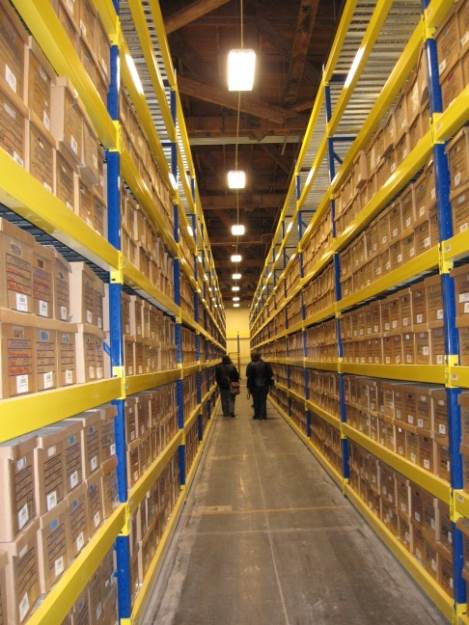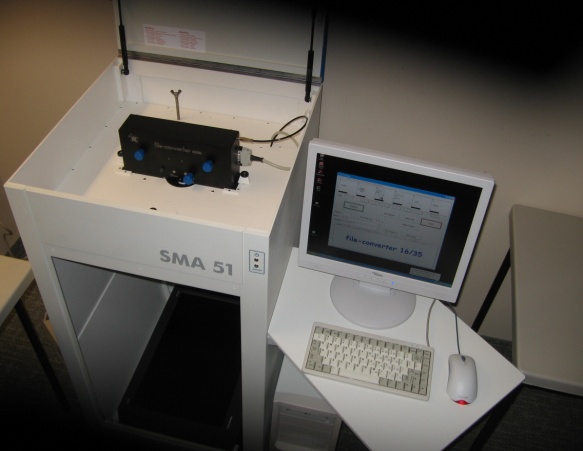
|
Records Management Essentials |
Home  Records Management Essentials
Records Management Essentials  Section 1
Section 1  1.5. Duties of the Division of Archives and Records Service (63A-12-101)
1.5. Duties of the Division of Archives and Records Service (63A-12-101)
1.5. Duties of the Division of Archives and Records Service (63A-12-101)
Utah State Archives and Records Service is a division within the Department of Administrative Services (DAS). It is most often referred to just as the State Archives. The Public Records Management Act (PRMA) outlines the responsibilities of the State Archives, which include oversight of the state’s records management program and providing records management services to all governmental entities. The Archives provides direction and assistance to all governmental entities through developing and maintaining retention schedules, through training, and by establishing and publishing standards and guidelines. The Archives provides staff support for the State Records Committee and Records Management Committee, administers the Public Notice Website, and appoints a Government Records Ombudsman. The Archives is the authorized repository for historical government records and provides access to them in the Research Center and online.

Administer the state’s archives and records management programs
As one element of the state’s records management program, Utah State Archives and Records Service manages the State Records Center in Clearfield to provide warehouse storage of paper records for governmental entities. Records stored here remain in the custody of the governmental entity. A general guideline is that records are eligible for records center storage if they are accessed less frequently than once a month. Although there is no storage cost, records must be housed in standard boxes and delivered to the center or sent through State Mail. When records are needed for any reason governmental entities may request that the Archives pull and return boxes or files. The Archives does not provide any public access to these records. Additional information about storing records in the State Records Center is available at archives.utah.gov/recordsmanagement/records-storage.html.
The State Archives operates a reformatting program to help facilitate long-term preservation. In its imaging center the Archives reformats records through the use of digitization, microfilming, and digital-to-microfilm and microfilm-to-digital conversion.

Although microfilm is becoming an obsolete access format, it is a viable format for long-term preservation. The Archives still microfilms some historical and long-terms records, and develops film from lingering microfilm cameras around the state. Digital images are being converted to microfilm in order to create a preservation copy of records for which permanent retention is critical. Typically, the microfilm is being created from images that are transferred to the Archives through a safe file transfer, and governmental entities are keeping the digital images for their own use.
As the use of microfilm and microfiche is diminishing, the Archives imaging center is digitizing images stored on these media to make them more accessible. 
More information as well as a fee schedule for Archives services is available at www.archives.state.ut.us/micrographics/index.html.
Establish standards and develop training
All governmental entities are responsible for managing their own records with assistance from the State Archives. In addition to tangible services, the Archives educates and assists records officers. Archives outreach efforts include the following:
- The Archives publishes guidelines, which are available on the Archives’ website. For example, email guidelines and social media guidelines are designed to help government employees manage email and social media. Governmental entities may use these guidelines to develop their own email and social media policies.
- The Archives publishes a blog, News From the Archives, in order to communicate information to records officers about upcoming events, general schedule proposals, and records management topics. Records officers who subscribe to the blog at archivesnews.utah.gov will receive an email notice about new posts.
- The Archives provides training on both records management (PRMA) and records access (GRAMA). The Archives hosts conferences and webinars on records issues, and responds to requests for training and invitations to speak at special events. It is also the specific responsibility of the State Archives to provide online certification. All records officers are required to complete online training and to annually certify by passing an online test (with a score of at least 75%), with the exception of records officers for the courts and legislature. The State Archives provides a list of all records officers and their certification statuses on its website at archives.utah.gov/opengovernment/aro-reports.html.
- Archives RIM specialists are available to answer records management questions, and upon request will make in-office visits to assist with records inventories or training.
- The Archives manages the Public Notice Website and provides assistance on its use.
- The Archives provides support to the Records Management Committee, which approves records retention schedules, and to the State Records Committee which hears appeals on records access issues.
- The Archives appoints a Government Records Ombudsman whose job is to understand the Government Records Access and Management Act (GRAMA), and to assist records officers who are responding to GRAMA requests and to mediate disputes over records issues upon request.
- The Archives publishes model forms for records officers to use for sharing records of responding to records requests.
- The Archives hosts the Open Records Portal, which is a central online location where anyone can make a GRAMA request to any governmental entity. The Open Records Portal includes the name and contact information for records officers who respond to GRAMA requests. It also provides links to online records and series-specific retention schedules.
Prepare schedules for the appropriate retention and orderly disposal of government records.
A primary role of the State Archives is to establish standards for the preparation of retention schedules for government records (Utah Code 63A-12-101(2)(e)). One part of this is the creation and maintenance of general, or model, retention schedules. The process for creating and approving a general retention schedule includes the following steps:
- The State Archives identifies a need to create a new general retention schedule or to update an existing general retention schedule. This need can become evident through suggestions received from members of Archives staff and/or from agency records officers, or it can be discovered while problem-solving records management issues.
- A RIM specialist at the State Archives drafts a general retention schedule.
- The RIM specialist distributes the draft to all identified stakeholders and solicits feedback.
- The State Archives modifies the drafted general retention schedule based on feedback, posts it as a draft on the website and blog to allow public comment, and distributes copies to members of the Records Management Committee (RMC) for their review.
- Members of the RMC discuss proposed schedules in an open meeting and approve or reject them by majority vote. Records Management Committee approval authorizes governmental entities to maintain and destroy records according to the schedule.
- If approved, the general retention schedule gets posted on the Archives website and supersedes all previous general retention schedules for the applicable records. Those general retention schedules that it replaces are discontinued and are linked with directions to the new general retention schedule.
- Open record series following a discontinued general retention schedule need to follow the new or updated general retention schedule. If this means that the retention or disposition of the record series changes, and the record series is documented in the Archives’ content management system, a RIM specialist at the State Archives contacts the records officer to notify them of the change. If the new retention or disposition do not meet the agency’s needs, the records officer needs to work with a RIM specialist at the State Archives to create a series-specific retention schedule for their record series.
The process for creating and approving a series-specific retention schedule for an agency includes the following steps:
- The government agency identifies and describes a record series, and submits to the State Archives a proposed retention schedule for the record series (Utah Code63A-12-103(5)).
- The State Archives inputs the record series into their content management system, which assigns it a record series number, then reviews the proposed retention and approves it or provides further direction.
- The governmental entity’s chief administrative officer reviews the proposed retention schedule and authorizes it with his or her signature.
- The State Archives posts the proposed retention schedule on its website to allow public comment and distributes copies to members of the Records Management Committee for their review.
- Members of the Records Management Committee discuss proposed schedules in an open meeting and approve them by majority vote. Proposed schedules not approved are returned for further consideration.
The State Archives posts approved retention schedules on its website. Records Management Committee approval authorizes governmental entities to maintain and destroy records according to the schedule.
All records produced by governmental entities must be organized into record series and must follow the retention of an RMC-approved general retention schedule or an RMC-approved series-specific retention schedule, per Utah Code 63G-2-604(1)(a), unless they were produced by a political subdivision who has created their own retention schedules for the records (and provided a copy of the schedules to the State Archives).
The State Archives is the authorized repository for historical government records
The State Archives is the official repository for the state’s historical records and the State Archivist is the official custodian of non-current records of permanent value. PRMA describes three situations in which records and their custody are to be transferred to the State Archives:
- When a governmental entity no longer wishes to maintain records that must be maintained or when historical records have met retention.
- When an agency becomes obsolete.
- When the State Archivist determines that records are not adequately being safeguarded and asks the attorney general to replevin them.
When custody of records is transferred to the State Archives, the Archives is thereafter responsible for preservation and storage as well as for providing access. The records are available through the Archives’ Research Center.